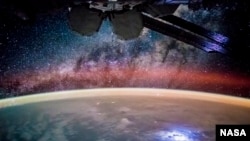A collection of radio telescopes that spans thousands of miles and is remotely operated from central New Mexico has measured a span of 66,000 light-years (one light-year is equal to 6 trillion miles) from Earth across the Milky Way's center to a star-forming area near the edge of the other side of the galaxy.
Astronomers say they hope to measure additional points around the galaxy to produce a map - the first of its kind - over the next decade.
Alberto Sanna of Germany's Max-Planck Institute for Radio Astronomy said in a news release that using the Very Long Baseline Array, which is remotely operated near Socorro, allows astronomers to “accurately map the whole extent of our galaxy,” the Albuquerque Journal reported.
Mark Reid, a senior radio astronomer at the Harvard-Smithsonian Center for Astrophysics who worked on the project, said they hope to create the map by measuring additional points around the galaxy. So far, they have measured around 200.
Reid said 100 or so observations must be done from the Earth's southern hemisphere, so he will be traveling to Australia in the future to use telescopes there.
Although the data for the 66,000 light-year measurement was collected in 2014 and 2015, the team has spent the time since then analyzing it, Reid said. “It's not like you get a Hubble (Space Telescope) space image,” he said.
While there are artistic renderings of what the Milky Way probably looks like, this effort will yield a highly accurate image, Reid said.




